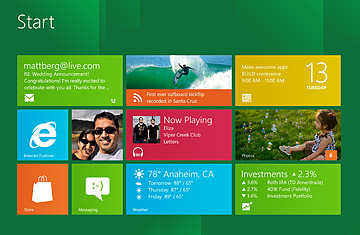
A screen shot from the new Windows 8 interface
(2 of 2)
Metro can be controlled with a keyboard and mouse, but it's going to shine on PCs with touchscreens. It's extremely finger-friendly, and as you use it, screens and other elements swoop around with a balletic grace that rivals that of the iPad. It is — this is not a word I'm used to applying to Microsoft products — beautiful.
It's also not a full-blown replacement for Windows as we know it — Microsoft isn't about to render indispensable non-Metro apps like its own Office obsolete. Instead, it's providing an app called Desktop that's like a slightly tweaked copy of Windows 7 cordoned off within Windows 8, letting you run your old programs and use familiar features such as the task bar. You'll probably want to use a keyboard and mouse with Desktop; using a touchscreen to tap icons, menus and other elements requires a precision that's hard to manage, at least if you're as fat-fingered as I am.
Desktop programs will work on PCs and tablets powered, like all existing PCs, by processors from Intel or AMD. Windows 8 will also run on computers that use processors based on technology from Intel competitor ARM, but these machines won't be able to use old-style Windows software without lots of heavy lifting on the part of developers. (How Microsoft and PC makers will explain the distinction between these multiple flavors of Windows remains to be seen.)
Everyone who sees Windows 8 has a reflexive, entirely understandable urge to compare it to the iPad. It'll unquestionably land on tablets designed to compete with Apple's device for sleek design and marathon battery life. But this upgrade reflects more grandiose ambitions than that. Despite growing talk of a post-PC era, Microsoft can't let the world come to regard the PC as a relic. So Windows 8 is going to show up on computing devices of all sorts: iPad rivals of various sizes, traditional desktops and laptops and new designs that split the difference between PC and tablet. A thousand flowers are going to bloom, or try to.
Naturally, Microsoft is pitching Windows 8's diversity — support for multiple types of programs running on a bevy of computers — as a major strategic advantage. More isn't always better, though: it's possible that Windows users will find the mashup of Metro and old-time Windows disorienting rather than liberating, or that they will find touch to be an unwieldy means of input on a desktop or notebook. As I used the Windows 8 preview on a Samsung tablet, I developed a new appreciation for Apple's willingness to say no. (It makes iPads in one size and doesn't let them run Mac apps even though doing so might have been technically feasible.)
Microsoft, in case you hadn't noticed, isn't Apple. As the creator of the software used in the vast majority of the planet's homes and businesses, its instinct is to try to please everybody, from clueless newbies to hard-core gamers to spreadsheet jockeys to IT managers. That's a tall order, especially since many Windows users are deeply skeptical about change of any sort, clinging to the decade-old Windows XP and refusing to deal with even the relatively minor differences in Windows Vista.
Give the company credit, though. This upgrade represents a roll of the dice that few large businesses would make with a wildly profitable product. Now it's up to developers to write outstanding Windows 8 applications and up to hardware makers to design irresistible Windows 8 computers. Here's hoping they make the most of the incredibly ambitious platform that Microsoft is building for them.
McCracken blogs about personal technology at Technologizer, which he founded in 2008 after nearly two decades as a tech journalist; on Twitter, he's @harrymccracken. His column, also called Technologizer, appears every Thursday on TIME.com.
